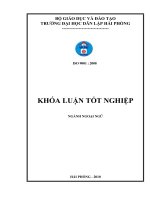Writing simple sentences in english
Bạn đang xem bản rút gọn của tài liệu. Xem và tải ngay bản đầy đủ của tài liệu tại đây (16.35 KB, 2 trang )
Writing simple sentences in English
Sentences with adjectives
Subject + be + adjective
In this pattern we use an adjective to describe the subject of a sentence.
He is intelligent.
She is beautiful.
It is easy.
We are happy.
Note that we cannot use articles before an adjective. However, if the adjective is followed by a singular noun we
have to use an article or another determiner.
She is a beautiful girl. (NOT She is beautiful girl.)
It was a difficult situation. (NOT It was difficult situation.)
He is a dangerous criminal. OR He is dangerous.
If the adjective is followed by a plural noun, the article
a/an
cannot be used.
They are kind people. (NOT They are a kind people.)
John and Peter are close buddies. (NOT John and Peter are a close buddies.)
Add prepositional phrases to your sentences
By adding short prepositional phrases to your sentence, you can tell when or where something happens.
A prepositional phrase is a group of words that begins with a preposition. The prepositional phrase usually goes at
the end of the sentence.
He is
in his office.
He sat
under a tree.
There is someone
at the door.
The crocodiles snapped
at the boat.
Put the books
on the table.
There are many apples
on the tree.
A gang stood
in front of me.
The castle was heavily bombed
during the war.
Writing sentences using other verbs
The simplest sentences in English take the verb
be
, but
be
is not the only verb in English.
Be
is actually a primary
auxiliary verb. The vast majority of verbs in English belong to a category called
lexical verbs
.
He works at a factory.
I tripped over the cat.
He fell off the ladder.
Be first to know when grammar rules change! Sign up to our newsletter here: englishgrammar.org (It's free)
Powered by TCPDF (www.tcpdf.org)









